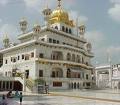 Vancouver, Canada: Akal Takht has directed members of one group of Sikhs of Canada to explain their “forging unity” after recent parleys in Surrey (Canada) with another group of Sikhs who were ex-communicated from the Sikh Panth for violating its 1997 edict prohibiting partaking of langar by Sikhs on and chairs.
Vancouver, Canada: Akal Takht has directed members of one group of Sikhs of Canada to explain their “forging unity” after recent parleys in Surrey (Canada) with another group of Sikhs who were ex-communicated from the Sikh Panth for violating its 1997 edict prohibiting partaking of langar by Sikhs on and chairs.
Moderate Sikh leaders of Vancouver-based Ross Street gurdwara and hardliners controlling the Surrey’s Dashmesh Darbar gurdwara had met last month and had announced truce by over seven-point programme “in the larger interests of the Sikhs” .
Apart from deciding on separate Baisakhi processions on separate weekends in Surrey and Vancouver, the two sides had stipulated the “common unity programme” was to resolve issues like gang violence, dera culture and drug menace in the Sikhs .
The meeting of the hardliners and moderates following decades of “ideological differences” and subsequent “truce”, however, had splinter groups alleging the leaders of the two groups had agreed to join forces to achieve “opportunistic goals” and woo more donations.
Akal Takht Jathedar Giani Gurbachan Singh, sources pointed out, had asked leaders of one of one group, backing the 1997 Akal Takht edict over langar issue till recently, to explain if its meeting with any or all ex-communicated leaders.
The letter seeking explanation of persons, who had been supporting the 1997 edict so far, has reached Vancouver and hardliners, it was learnt, were busy to find out an “acceptable” explanation. Reply to the explanation was expected to be sent to the Jathedar, on US tour, in a week or so, said one of his aides.
On the complaints of certain Sikhs, then Akal Takht Jathedar Bhai Ranjit Singh had ex-communicated Sikh leaders, Kashmir Singh Dhaliwal, Jarnail Singh Bhandal, then president of the Ross Street Sikh Temple, Giani Harkirat Singh, Balwant Singh Gill and Tara Singh Hayer, a Vancouver-based journalist who, was later killed in Vancouver in 1998, for defying the edict barring Sikhs from partaking of langar by sitting on chairs.
These leaders, it was learnt, had supported old practice of a section of Canada-based Sikhs partaking of langar using tables and chair with explanation they were adhering to the practice since 1906 “much before the setting up of the SGPC” and owing to harsh weather prevailing in North America when central heating system was not so efficient.
 Sikh Sangat News Celebrating Sikh culture and sharing Sikh voices
Sikh Sangat News Celebrating Sikh culture and sharing Sikh voices

The sikh religion is a scientfic religion. Some dicisions can be taken according the situations in diffirent parts of the world. Some modyfications without touching the philosophy of sikhism and knowing the wisdom of the traditions.To eat langar in lines and sitting at ground means that in sikhism all are equal. The basic question is of equality and eat in dicipline and not of sit on ground or on chairs but one thing which is more important in my opinion is that their should be both types of arrangments irrespective of controversies.Under stand the purpose behind the tradition.BUT it is easy to serve the langar while sitting on ground in pangat. SO it is need to understand the meaning. A great number of preachers and jathedars of sikhism are living their lives not according the sikh philosophy and they are working under the traditions and customs of snatan mat not according GURUMAT. LORD GOD BLESS THEM,